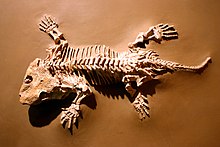
Back عظائيات الفحم Arabic Antracosaures Catalan Anthracosauria German Anthracosauria Spanish زغالخزندهسانان Persian Anthracosauria Finnish Anthracosauria French 炭竜目 Japanese 탄룡 Korean Anthracosauria Dutch
| Anthracosauria Temporal range: Mississippian to Late Triassic
| |
|---|---|

| |
| The skeleton of Seymouria baylorensis | |
| Scientific classification | |
| Domain: | Eukaryota |
| Kingdom: | Animalia |
| Phylum: | Chordata |
| Clade: | Sarcopterygii |
| Clade: | Tetrapodomorpha |
| Clade: | Stegocephali |
| Order: | Anthracosauria Säve-Söderbergh, 1934 |
| Subgroups | |
Anthracosauria is an order of extinct reptile-like amphibians (in the broad sense) that flourished during the Carboniferous and early Permian periods, although precisely which species are included depends on one's definition of the taxon. "Anthracosauria" is sometimes used to refer to all tetrapods more closely related to amniotes such as reptiles, mammals, and birds, than to lissamphibians such as frogs and salamanders. An equivalent term to this definition would be Reptiliomorpha. Anthracosauria has also been used to refer to a smaller group of large, crocodilian-like aquatic tetrapods also known as embolomeres.